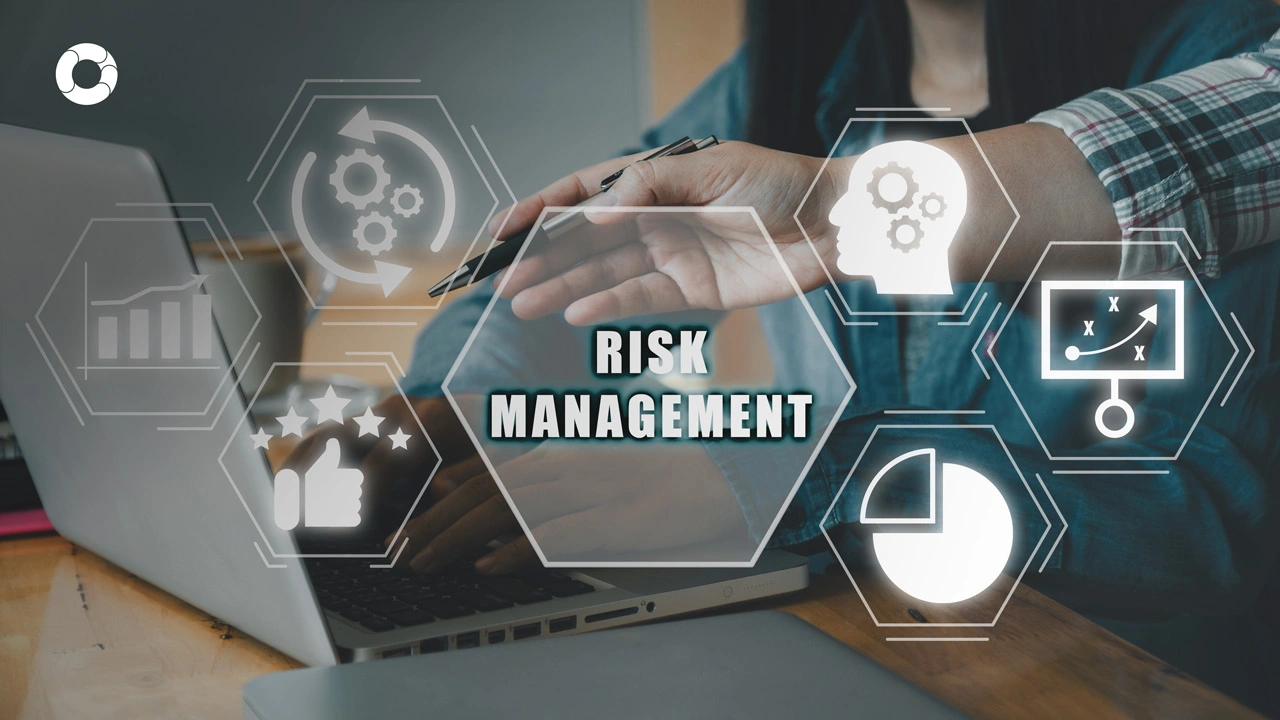Navigating Risk Management in Banking: A Complete Guide

In today’s regulation and risk-heavy banking world, risk management plays a crucial role in protecting financial institutions from various uncertainties. It’s a complex task dealing with rules, changing markets, and how people use money.
Banks face many risks, like how they work, lend money, and deal with changing markets, plus new threats like online security and following rules.
Institutions must grapple with many risks encompassing operational, credit, market dynamics, and emerging challenges like cybersecurity threats and compliance demands.
To quote Simon Perry, Head of Markets & Services of Risk in PwC UK, “These threats mean taking risk intelligently—powered by technology and framed by growth and opportunity—is now critical to adapting and reinventing yourself in this constantly changing world to both protect and create value.”
From dissecting various risk types to exploring regulatory compliance, this article aims to equip banking professionals with essential insights and strategies for navigating the complexities of risk management effectively.
Understanding the Scope of Banking Risks
While the types of risk and levels faced can evolve over time, they can generally be categorized into four facets.
Operational Risks
Operational risks within the banking sector encompass a wide array of uncertainties originating from internal processes, information systems, human errors, or external factors.
These include:
- Technology failures
- Fraud
- Compliance lapses
- Disruptions in banking operations due to unforeseen events
For example, IT system breakdowns or cyberattacks can severely impact customer service, financial transactions, and data security, making operational risk management a critical focus area. This can also feed in and affect reputational risks.
Credit Risks
Credit risks pose a substantial threat to banks, arising from borrowers’ inability to repay debts or loans. These risks directly influence a bank’s profitability and financial health.
Economic downturns, changes in interest rates, and borrowers' creditworthiness impact credit risk exposure necessitating vigilant credit risk assessment and management to mitigate potential losses.
Market Risks
Market risks in banking emerge from fluctuations in interest rates, currency values, or changes in equity prices.
Source: PwC
Market risks affect a bank’s trading portfolios, investments, and financial instruments.
Banks must closely monitor market movements and implement hedging strategies to mitigate the adverse impacts of market fluctuations and reduce any financial losses from fluctuating capital markets.
Liquidity Risks
Liquidity risks relate to a bank’s ability to meet its short-term financial obligations. Insufficient liquid assets to cover short-term liabilities can severely impair a bank's operations and financial stability, posing a form of financial risk.
Regulatory requirements mandate maintaining adequate liquidity reserves, making liquidity risk management a crucial aspect of managing risk in banking operations. This is focused on a metric in the banking industry due to past bank failures and financial crises arising from insufficient liquidity.
Risk Management Strategies for Banks
Risk Assessment Techniques
Banks employ diverse assessment and risk reporting methodologies encompassing quantitative and qualitative approaches.
Some popular initiatives used include:
- Stress testing
- Scenario analysis
- Historical data evaluation
- Predictive modeling
By employing these techniques, banks gain insights into various risk categories and their potential impacts.
Risk Mitigation Practices
Mitigating risks in the banking sector involves deploying various strategies to reduce dependencies
Some of the most commonly used practices are:
- Diversification of assets
- Effective hedging
- Setting risk limits
- Establishing robust internal controls
Banks leverage these strategies to minimize the adverse effects of risks and protect their financial stability and performance.
Compliance and Regulatory Frameworks
Adherence to regulatory changes is a must in banking. Banks must comply with stringent regulations to maintain integrity, protect consumers, and ensure financial stability.
Implementing comprehensive compliance programs, regular audits, and robust governance structures helps banks align with regulatory mandates and mitigate potential compliance risks.
The Role of Technology in Banking Risk Management
Undoubtedly, technology plays a critical role in banking risk management. This can broadly be divided into fintech innovations and risk management software solutions.
Fintech Innovations
Fintech innovations have revolutionized risk management practices in the banking sector.
These advancements offer agile solutions, utilizing artificial intelligence (AI), machine learning (ML), and data analytics to predict, identify, and mitigate risks more efficiently.
In fact, according to the latest study by McKinsey, as of July 2023, publicly traded fintechs represented a market capitalization of $550 billion which is a two-fold increase compared to 2019.
Risk Management Software Solutions
Risk management software solutions streamline complex banking operations by providing real-time risk monitoring, scenario modeling, and predictive analytics.
These technologies empower banks to:
- Analyze vast volumes of data
- Enhance decision-making
- Proactively address risks
This is especially critical for banks that face more regulation in areas such as anti-money laundering.
By leveraging these solutions, banks often witness improved operational efficiency, reduced costs, and enhanced risk identification and mitigation strategies.
Implementing Effective Risk Management in Different Sectors
Depending on the sector you belong to, the best practices and strategies you use can change. Here’s what to know for each.
Operational Risk Management
Banks rely on robust operational risk management to navigate complexities in their operations.
Some best practices to consider include
- Creating a risk-aware culture
- Regularly assessing potential operational risks
- Establishing efficient internal controls
By enhancing resilience against operational challenges, banks can maintain stability in their day-to-day functions.
B2B Financial Services
B2B financial services demand tailored risk management strategies.
These involve:
- Understanding the unique risk profile of business clients
- Offering personalized risk mitigation solutions to clients
- Ensuring compliance with specific regulatory standards
Establishing trust through effective risk management fosters enduring relationships with corporate clients.
Mid-Market Companies
Mid-market companies require agile risk management frameworks to adapt to growth-related challenges.
These strategies include:
- Identifying growth-associated risks
- Establishing risk tolerance levels
- Ensuring that risk management aligns with your strategic objectives
By addressing risks proactively, mid-market companies pave the way for sustainable growth.
Insurance Companies
Risk management in insurance companies involves managing diverse risks, including underwriting, market, and regulatory risks.
Insurance companies are often focused on:
- Risk diversification
- Rigorous stress testing
- Compliance with stringent insurance regulations
Implementing specialized risk management practices safeguards policyholders and enhances the company's financial stability.
Choosing the Right Risk Management Software
It’s important to understand that financial risk management software does not exist. That said, when choosing the right risk management software for you, make sure to consider the following factors:
- Look for software that offers comprehensive risk assessment methodologies, enabling your institution to identify, analyze, and prioritize risks effectively within your risk management program. Tools like risk matrices, scenario analysis, and heat maps aid in this process.
- Prioritize software with real-time monitoring features that enable continuous surveillance of potential risks and swift responses to emerging threats or changes in risk profiles.
- The software should offer customizable reporting features, allowing you to generate reports tailored to senior management needs and other stakeholders.
- The chosen software should be scalable to accommodate the growth and changing needs of your institution.
- Look for software with intuitive and user-friendly interfaces to ensure ease of use and adoption across your organization.
Pirani Risk offers cutting-edge software solutions tailored for the banking sector.
Our software not only fulfills all the above categories but stands out due to its:
- Intuitive UI promises ease of use for all stakeholders
- Streamlined navigation and accessibility across all skill levels
- Continuous surveillance and real-time risk tracking
- Immediate alerts and notifications for emerging threats
- Customizable dashboards fine-tuned for your use
- Optimized data flow and analyses
Pirani’s ability to integrate with various banking systems and its compliance with industry standards as well as new regulations make it a reliable choice for banks seeking comprehensive risk management solutions.
Fortify Your Bank with Pirani Risk
Effective risk mitigation is not just a necessity but a strategic imperative in ensuring the resilience of financial institutions against being victims of financial crime.
Pirani Risk offers tailored solutions specifically designed to meet the enterprise risk needs of the banking sector.
From real-time risk tracking to customizable dashboards, extensive analytics tools, seamless integration capabilities, compliance adherence, and specialized features addressing banking-specific risks, Pirani Risk empowers financial providers and business units to navigate the complexities of risk with confidence.
To fortify your financial entity’s security, consider Pirani today and take the first step toward securing your bank’s risk management capabilities.
Contact us today to explore our solutions and schedule a demonstration tailored to your banking needs.
You May Also Like
These Related Stories

Get to know the fundamental principles of Basel in banking

How to manage credit risk

White-collar criminals: Profiles, cases & risk management
The collapse of Silicon Valley Bank and its inadequate risk management

Why do banks retain inactive customer data?

No Comments Yet
Let us know what you think